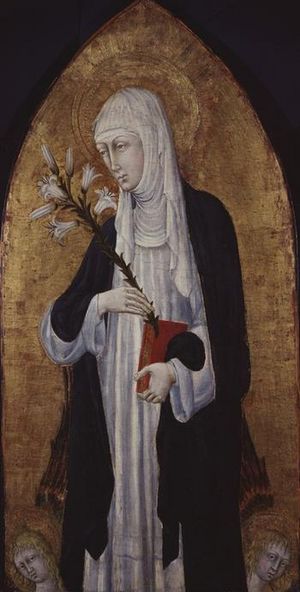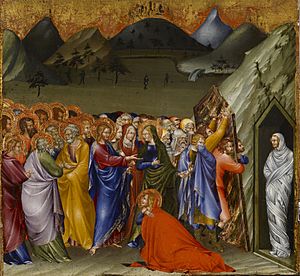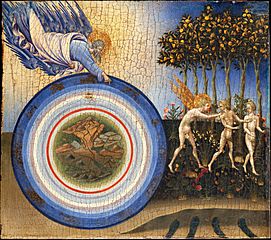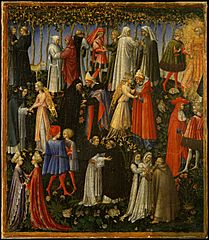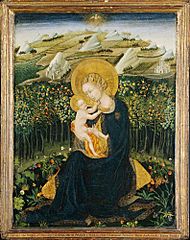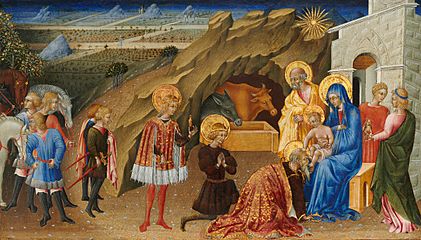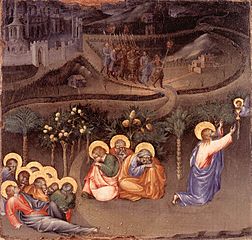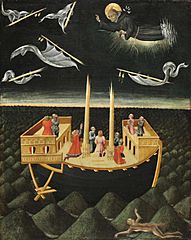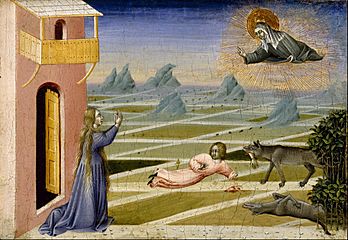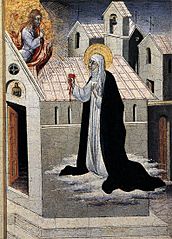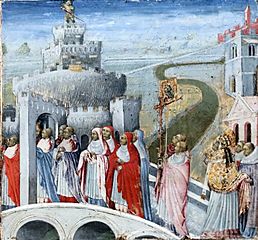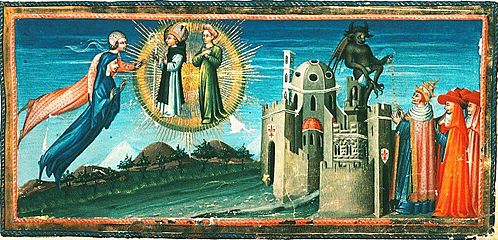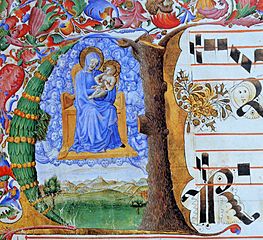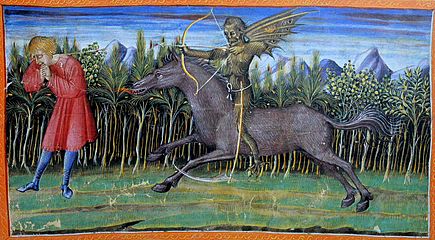Giovanni di Paolo facts for kids
Giovanni di Paolo di Grazia (born around 1403, died 1482) was an Italian painter. He worked mainly in Siena, a city in Italy. Giovanni was a very busy artist who painted many pictures and also illustrated books. He even illustrated some of Dante's famous writings.
He was one of the most important painters from Siena in the 1400s. At first, his art showed influences from older Sienese artists. But later, he developed his own special style. This style often used cool, strong colors and stretched-out shapes. He was also inspired by artists like Gentile da Fabriano, who used a style called International Gothic. Many of Giovanni's paintings have a dreamlike feel, almost surreal. An example is his Miracle of St. Nicholas of Tolentino from around 1455. His later works, like Last Judgment, Heaven, and Hell (around 1465) and Assumption (1475), are quite unique. After he died, people didn't talk about his art much, but in the 1900s, his work became famous again.
Contents
Early Life and Art
We don't know the exact year Giovanni di Paolo was born. The first time we find a record of him is in 1417. He was working for the Dominican Order in Siena as a miniaturist. This means he was an artist who decorated and illustrated manuscripts (old books written by hand).
Some people think his art shows influences from northern Europe, especially in his landscapes. They wonder if he learned from the Limbourg Brothers, who were in Siena around 1413. However, this isn't certain. It's also thought he might have learned from Taddeo di Bartolo and Martino di Bartolomeo.
Most of Giovanni's early jobs came from local churches and monasteries. This is why many of his first paintings are altarpieces. An altarpiece is a work of art placed behind the altar in a church. For example, he painted The Virgin and Christ Child with Saints and The Lamentation Over the Dead Christ. These were made for a cathedral that Pope Pius II had just finished.
Artworks and Inspirations
Many of Giovanni di Paolo's famous paintings today are actually parts of larger altarpieces. These altarpieces were taken apart over time. Pieces of them, called "predellas" (the bottom part of an altarpiece), are now in museums worldwide.
For example, he painted a series of panels about Saint Catherine of Siena and Saint Clare of Assisi. He also painted scenes from the life of Saint John the Baptist. These pieces are now spread out in museums across Europe and North America.
Giovanni di Paolo painted four altarpieces for chapels in a church called San Domenic. These include Christ Suffering and Triumphant (early 1420s) and the Guelfi Altarpiece (1445). A part of the Guelfi Altarpiece, called Paradise, is now in the Metropolitan Museum of Art in New York.
Giovanni di Paolo was inspired by many great artists from the 1300s and 1400s in Italy. It's thought he might have had a "model book." This book would contain drawings or ideas from other artists' works. He could look through it and use parts that fit his own paintings.
Some artists who inspired him were Gentile da Fabriano, Ambrogio Lorenzetti, and Donatello. Giovanni would change and combine these ideas to make them his own. Even though copying might be frowned upon today, in Siena during his time, it was valued. Artists who could creatively use others' work were admired.
Giovanni's Raising of Lazarus painting, for example, is based on a similar scene by Duccio. Duccio's figures are calm, but Giovanni's are lively and full of emotion. Giovanni was open to new ideas, not just the traditional Sienese style. His art shows the change from the Gothic style to the Renaissance period.
He was also influenced by International Gothic artists like Gentile da Fabriano. Gentile was a very important artist who visited Siena. Giovanni quickly learned Gentile's techniques. One thing he learned was Gentile's interest in nature. Instead of just painting standing saints, Giovanni would add flowering plants to his art.
Giovanni di Paolo's Adoration of the Magi and Gentile da Fabriano's Adoration of the Magi show this. Both artists used nature, but Giovanni made it his own. Gentile's art could be dark, but Giovanni saw nature as pure and kind. He took these ideas and filled them with his own personal meaning.
In his later years, Giovanni's imagination was still strong, but his painting skills might have weakened. Assistants likely helped him finish his work. He made his last will on January 29, 1484, and died before March 27 of that year.
Unique Style
Later in his life, Giovanni became very good at painting illuminated manuscripts. These are books with beautiful, hand-painted decorations. He decorated choir books for monks and also illustrated Dante's famous poem, Divine Comedy.
The pictures he made for Dante's poem are some of his most famous and well-preserved works. In these illustrations, you can see how Giovanni di Paolo was different from other Sienese artists. He might have met artists from Northern Europe who were in Siena when he was young. Their influence might be why his landscapes look like those in the famous painting by the Limbourg brothers, Tres Riches Heures.
His teacher, Taddeo di Bartolo, probably taught him to paint with strong, clear lines. You can see this in all his works. The most amazing thing about Giovanni di Paolo's art is its fantastical, dreamlike quality. Art expert John Pope-Hennessy said that looking at Giovanni's work is like stepping through a looking-glass, just like Alice.
For example, in his Madonna of Humility (1435), the checkerboard landscape behind the garden scene looks like a world beyond. Giovanni often used this checkerboard effect. It helps create a feeling of wide-open space, inviting you to imagine flying through a dream.
Illuminating Dante's Paradiso
In 1441, Giovanni di Paolo was chosen to lead the painters' guild. This made him the perfect choice to illustrate Dante's Paradiso. This work is now known as "The Yates Thompson Dante." Giovanni created 61 images for this poem. Two other artists worked on the illustrations for Inferno and Purgatorio.
Giovanni di Paolo used his special style to create bright, sunny landscapes for Paradiso. His pictures were much lighter and fresher than those in the other two parts of the poem.
One painting inspired by these illustrations is The Creation and The Expulsion from Paradise (1445). It's in the Metropolitan Museum of Art. Giovanni created a unique image by showing two scenes at once. God floats above the universe, and Adam and Eve are being kicked out of Paradise.
One idea is that God is doing both at the same time. But why isn't his hand pointing directly to Earth? Some believe that if you follow God's gaze, your eye goes to a specific point on the Zodiac circle. Looking at the 11 o'clock position, you can see the symbol for Pisces. Following the circle, Aries is at 12 o'clock and Taurus at 1 o'clock. In medieval times, these signs represented spring. More importantly, they represented the season of the Feast of the Annunciation (March 25).
So, God seems to be pointing to March 25. This might be to remind the viewer of the Annunciation's importance. It also reminds us of why Christ came to Earth: to fix the "Fall" caused by Adam and Eve and to save humanity from sin.
Another interesting part of this painting is that Earth is surrounded by colorful rings. At that time, most people believed the Earth was the center of the universe. So, Giovanni might have been following Dante's description of Earth surrounded by heavenly spheres. However, Dante only mentioned ten circles, but Giovanni painted twelve. Some experts think Giovanni was using a book called the Sphera. This book helped people understand the universe based on ancient Greek ideas, which could explain the number and colors of his circles.
Gallery: Tempera Paintings
Illuminated Manuscripts
Some of His Works
- Madonna and Child with Angels (1426)
- Saint Ansanus Baptizing (1440s). Christian Museum, Esztergom, Hungary
- Saint Michael the Archangel (1440) Pinacoteca Vaticana, Vatican City, Rome, Italy
- Madonna and Child with Two Angels and a Donor (1445). Metropolitan Museum of Art, New York, United States
- Saints Clare and Elizabeth of Hungary (1445). Private collection.
- Madonna and Child with Saints (1445). Uffizi Gallery, Florence, Italy
- Saint John The Baptist in Prison Visited by Two Disciples (1445/60). Art Institute of Chicago, United States
- Saint Stephen Suckled by a Doe (1450). San Stefano alla Lizza, Siena, Italy
- Saint John the Baptist Goes into the Wilderness (1454). Art Institute of Chicago, United States
- Saint Nicholas of Tolentino Saving a Ship (1455). Philadelphia Museum of Art, United States
- Coronation of the Virgin (1455). Metropolitan Museum of Art, New York, United States
- Nativity (1460s). Christian Museum, Esztergom, Hungary
- Saint Catherine before the Pope at Avignon (1460). Thyssen-Bornemisza Museum, Madrid, Spain
- The Adoration of the Magi (1462). Metropolitan Museum of Art, New York, United States
- The Virgin and Christ Child with Saints Bernardino, Anthony Abbot, Francis and Sabina and The Lamentation over the Dead Christ (1462–63). Pienza Cathedral, Italy
- Madona and Christ at Throne (around 1462–1465). National Museum of Serbia, Belgrade, Serbia
- Last Judgment, Heaven, and Hell (1465). Pinacoteca, Siena, Italy
- Assumption of the Virgin (1475). Pinacoteca, Siena, Italy
See also
 In Spanish: Giovanni di Paolo para niños
In Spanish: Giovanni di Paolo para niños


